Arctic Wind, Sea Ice, and the Corresponding Characteristic Relationship
Abstract
:1. Introduction
2. Data and Methods
2.1. Data
2.2. Methods
3. Frequency Distribution of SIC and Strong Winds above Force Six
4. Sea Ice and Wind Field Correlation Analysis
4.1. Correlation between Sea Ice and Different Incoming Winds
4.1.1. SIC Distribution under Different Incoming Winds
4.1.2. Correlation under Different Incoming Winds and SIC
4.2. Contribution of Different Incoming Winds and Strong Winds to Sea Ice
4.2.1. Seasonal Contribution of Different Wind Frequencies to Frequencies of SIC Less Than 20%
4.2.2. Contribution of Strong Winds above Force Six to the Frequencies of SIC Less Than 20%
5. Discussion
6. Conclusions
Author Contributions
Funding
Institutional Review Board Statement
Informed Consent Statement
Data Availability Statement
Acknowledgments
Conflicts of Interest
References
- China’s Arctic Policy. Available online: https://www.gov.cn/zhengce/2018-01/26/content_5260891.htm (accessed on 14 July 2024).
- Rantanen, M.; Karpechko, A.Y.; Lipponen, A.; Nordling, K.; Hyvärinen, O.; Ruosteenoja, K.; Vihma, T.; Laaksonen, A. The Arctic Has Warmed Nearly Four Times Faster than the Globe since 1979. Commun. Earth Environ. 2022, 3, 168. [Google Scholar] [CrossRef]
- Jiang, S.; Hu, H.; Perrie, W.; Zhang, N.; Bai, H.; Zhao, Y. Different Climatic Effects of the Arctic and Antarctic Ice Covers on Land Surface Temperature in the Northern Hemisphere: Application of Liang-Kleeman Information Flow Method and CAM4.0. Clim. Dyn. 2022, 58, 1237–1255. [Google Scholar] [CrossRef]
- Serreze, M.C.; Francis, J.A. The Arctic Amplification Debate. Clim. Change 2006, 76, 241–264. [Google Scholar] [CrossRef]
- Dai, A.; Luo, D.; Song, M.; Liu, J. Arctic Amplification Is Caused by Sea-Ice Loss under Increasing CO2. Nat. Commun. 2019, 10, 121. [Google Scholar] [CrossRef]
- Fang, M.; Li, X.; Chen, H.W.; Chen, D. Arctic Amplification Modulated by Atlantic Multidecadal Oscillation and Greenhouse Forcing on Multidecadal to Century Scales. Nat. Commun. 2022, 13, 1865. [Google Scholar] [CrossRef]
- Chen, X.; Dai, A. Response of Meridional Wind to Greenhouse Gas Forcing, Arctic Sea-Ice Loss, and Arctic Amplification. J. Clim. 2022, 35, 7275–7297. [Google Scholar] [CrossRef]
- Jenkins, M.; Dai, A. The Impact of Sea-Ice Loss on Arctic Climate Feedbacks and Their Role for Arctic Amplification. Geophys. Res. Lett. 2021, 48, e2021GL094599. [Google Scholar] [CrossRef]
- Sijia, Z.; Lidaling, Y. Computer Simulation of the Influence on Sea Ice Concentration Caused by Sea Surface Temperature and Sea Level Pressure. In Proceedings of the 2012 International Conference on Computing, Measurement, Control and Sensor Network, Taiyuan, China, 7–9 July 2012; pp. 261–264. [Google Scholar]
- Candlish, L.M.; Iacozza, J.; Lukovich, J.V.; Horton, B.; Barber, D.G. Sea Ice Climatology in the Canadian Western Arctic: Thermodynamic versus Dynamic Controls. Int. J. Climatol. 2015, 35, 1867–1880. [Google Scholar] [CrossRef]
- Ohshima, K.I.; Yoshida, K.; Shimoda, H.; Wakatsuchi, M.; Endoh, T.; Fukuchi, M. Relationship between the Upper Ocean and Sea Ice during the Antarctic Melting Season. J. Geophys. Res.-Ocean. 1998, 103, 7601–7615. [Google Scholar] [CrossRef]
- Shen, X.-Y.; Zhang, Y.; Chen, C.-S.; Hu, S.; Xu, D.-Y.; Shao, W.-Z.; Chang, L.; Feng, G.-P. Arctic Sea Ice Variation in the Northwest Passage in 1979-2017 and Its Response to Surface Thermodynamics Factors. Adv. Clim. Change Res. 2021, 12, 563–580. [Google Scholar] [CrossRef]
- Ding, Q.; Schweiger, A.; Baxter, I. Nudging Observed Winds in the Arctic to Quantify Associated Sea Ice Loss from 1979 to 2020. J. Clim. 2022, 35, 6797–6813. [Google Scholar] [CrossRef]
- Mallett, R.D.C.; Stroeve, J.C.; Cornish, S.B.; Crawford, A.D.; Lukovich, J.V.; Serreze, M.C.; Barrett, A.P.; Meier, W.N.; Heorton, H.D.B.S.; Tsamados, M. Record Winter Winds in 2020/21 Drove Exceptional Arctic Sea Ice Transport. Commun. Earth Environ. 2021, 2, 149. [Google Scholar] [CrossRef]
- Ding, Q.; Schweiger, A.; L’Heureux, M.; Battisti, D.S.; Po-Chedley, S.; Johnson, N.C.; Blanchard-Wrigglesworth, E.; Harnos, K.; Zhang, Q.; Eastman, R.; et al. Influence of High-Latitude Atmospheric Circulation Changes on Summertime Arctic Sea Ice. Nat. Clim. Change 2017, 7, 289–295. [Google Scholar] [CrossRef]
- Wernli, H.; Papritz, L. Role of Polar Anticyclones and Mid-Latitude Cyclones for Arctic Summertime Sea-Ice Melting. Nat. Geosci. 2018, 11, 108–113. [Google Scholar] [CrossRef]
- Graham, R.; Itkin, P.; Meyer, A.; Sundfjord, A.; Spreen, G.; Smedsrud, L.; Liston, G.; Cheng, B.; Cohen, L.; Divine, D.; et al. Winter Storms Accelerate the Demise of Sea Ice in the Atlantic Sector of the Arctic Ocean. Sci. Rep. 2019, 9, 9222. [Google Scholar] [CrossRef]
- Duvivier, A.; Holland, M.; Vavrus, S.; Landrum, L.; Shields, C.; Thaker, R. Arctic Sea Ice Loss Drives Increasing Arctic Wind Speeds with Combined Impact on Surface Roughness and Boundary Layer Stability. Res. Sq. 2022. [Google Scholar] [CrossRef]
- Crawford, A.; Lukovich, J.; McCrystall, M.; Stroeve, J.C.; Barber, D. Reduced Sea Ice Enhances Intensification of Winter Storms over the Arctic Ocean. J. Clim. 2022, 35, 3353–3370. [Google Scholar] [CrossRef]
- DuVivier, A.; Vavrus, S.; Holland, M.; Landrum, L.; Shields, C.; Thaker, R. Investigating Future Arctic Sea Ice Loss and Near-Surface Wind Speed Changes Related to Surface Roughness Using the Community Earth System Model. J. Geophys. Res. Atmos. 2023, 128, e2023JD038824. [Google Scholar] [CrossRef]
- Dai, A.; Song, M. Little Influence of Arctic Amplification on Mid-Latitude Climate. Nat. Clim. Change 2020, 10, 231–237. [Google Scholar] [CrossRef]
- Francis, J.A.; Vavrus, S.J. Evidence Linking Arctic Amplification to Extreme Weather in Mid-latitudes. Geophys. Res. Lett. 2012, 39, GL051000. [Google Scholar] [CrossRef]
- Francis, J.A.; Vavrus, S.J. Evidence for a Wavier Jet Stream in Response to Rapid Arctic Warming. Environ. Res. Lett. 2015, 10, 014005. [Google Scholar] [CrossRef]
- Liu, J.; Curry, J.A.; Wang, H.; Song, M.; Horton, R.M. Impact of Declining Arctic Sea Ice on Winter Snowfall. Proc. Natl. Acad. Sci. USA 2012, 109, 4074–4079. [Google Scholar] [CrossRef]
- Vihma, T. Effects of Arctic Sea Ice Decline on Weather and Climate: A Review. Surv. Geophys. 2014, 35, 1175–1214. [Google Scholar] [CrossRef]
- Screen, J.A. Far-Flung Effects of Arctic Warming. Nat. Geosci. 2017, 10, 253–254. [Google Scholar] [CrossRef]
- Rahmstorf, S.; Box, J.E.; Feulner, G.; Mann, M.E.; Robinson, A.; Rutherford, S.; Schaffernicht, E.J. Exceptional Twentieth-Century Slowdown in Atlantic Ocean Overturning Circulation. Nat. Clim. Chang. 2015, 5, 475–480. [Google Scholar] [CrossRef]
- Sévellec, F.; Fedorov, A.V.; Liu, W. Arctic Sea-Ice Decline Weakens the Atlantic Meridional Overturning Circulation. Nat. Clim. Chang. 2017, 7, 604–610. [Google Scholar] [CrossRef]
- Strawa, A.W.; Latshaw, G.; Farkas, S.; Russell, P.; Zornetzer, S. Arctic Ice Loss Threatens National Security: A Path Forward. Orbis 2020, 64, 622–636. [Google Scholar] [CrossRef]
- Tao, W.; Zheng, L.; Hao, Y.; Liu, G. An Extreme Gale Event in East China under the Arctic Potential Vorticity Anomaly through the Northeast China Cold Vortex. Adv. Atmos. Sci. 2023, 40, 2169–2182. [Google Scholar] [CrossRef]
- Qian, D.; Huang, Y.; Li, H.; Zhou, B.; Yin, Z.; Wang, H. Decadal Variations in the Summer Precipitation Over Eastern China Associated With Spring Arctic Sea Ice. J. Geophys. Res. Atmos. 2023, 128, e2023JD039231. [Google Scholar] [CrossRef]
- Liu, X.; Zhu, Z.; Lu, R.; Miao, Z.; Li, W.; Hsu, P. Unprecedented July Rainfall in North China in 2021: Combined Effect of Atlantic Warming and Arctic Sea-Ice Loss. J. Geophys. Res. Atmos. 2023, 128, e2022JD038068. [Google Scholar] [CrossRef]
- Hersbach, H.; Bell, B.; Berrisford, P.; Hirahara, S.; Horányi, A.; Muñoz-Sabater, J.; Nicolas, J.; Peubey, C.; Radu, R.; Schepers, D.; et al. The ERA5 Global Reanalysis. Q. J. R. Meteorol. Soc. 2020, 146, 1999–2049. [Google Scholar] [CrossRef]
- Çalışır, E.; Soran, M.; Akpinar, A. Quality of the ERA5 and CFSR Winds and Their Contribution to Wave Modelling Performance in a Semi-Closed Sea. J. Oper. Oceanogr. 2021, 16, 106–130. [Google Scholar] [CrossRef]
- Dai, A. The Diurnal Cycle from Observations and ERA5 in Surface Pressure, Temperature, Humidity, and Winds. Clim. Dyn. 2023, 61, 2965–2990. [Google Scholar] [CrossRef]
- Johannsen, F.; Ermida, S.; Martins, J.P.A.; Trigo, I.F.; Nogueira, M.; Dutra, E. Cold Bias of ERA5 Summertime Daily Maximum Land Surface Temperature over Iberian Peninsula. Remote Sens. 2019, 11, 2570. [Google Scholar] [CrossRef]
- Deng, X.; He, D.; Zhang, G.; Zhu, S.; Dai, R.; Jin, X.; Fu, W.; Shen, W.; Chen, J.; Fan, Y.; et al. Comparison of Horizontal Wind Observed by Wind Profiler Radars with ERA5 Reanalysis Data in Anhui, China. Theor. Appl. Climatol. 2022, 150, 1745–1760. [Google Scholar] [CrossRef]
- Serra, Y.; Rutledge, S.; Chudler, K.; Zhang, C. Rainfall and Convection in ERA5 and MERRA-2 over the Northern Equatorial Western Pacific during PISTON. J. Clim. 2022, 36, 845–863. [Google Scholar] [CrossRef]
- Jiang, Y.; Han, S.; Shi, C.; Gao, T.; Zhen, H.; Liu, X. Evaluation of HRCLDAS and ERA5 Datasets for Near-Surface Wind over Hainan Island and South China Sea. Atmosphere 2021, 12, 766. [Google Scholar] [CrossRef]
- Liudmyla, G.; Khrystiuk, B.; Shpyg, V.; Pishniak, D. Estimation of Tendencies, Homogeneity and Stationarity of Air Temperature at the Ukrainian Antarctic Akademik Vernadsky Station during 1951—2020. Geofiz. Zhurnal 2022, 44, 183–194. [Google Scholar] [CrossRef]
- Reguero, B.G.; Losada, I.J.; Mendez, F. A Global Wave Power Resource and Its Seasonal, Interannual and Long-Term Variability. Appl. Energy 2015, 148, 366–380. [Google Scholar] [CrossRef]
- Bhargava, A.; Echenique, J.A. An Econometric Analysis of Sea Surface Temperatures, Sea Ice Concentrations and Ocean Surface Current Velocities. J. Mar. Sci. Eng. 2022, 10, 1854. [Google Scholar] [CrossRef]
- Dyck, S.; Tremblay, L.B.; de Vernal, A. Arctic Sea-Ice Cover from the Early Holocene: The Role of Atmospheric Circulation Patterns. Quat. Sci. Rev. 2010, 29, 3457–3467. [Google Scholar] [CrossRef]
- Jakobson, L.; Vihma, T.; Jakobson, E. Relationships between Sea Ice Concentration and Wind Speed over the Arctic Ocean during 1979–2015. J. Clim. 2019, 32, 7783–7796. [Google Scholar] [CrossRef]
- Hughes, M.; Cassano, J.J. The Climatological Distribution of Extreme Arctic Winds and Implications for Ocean and Sea Ice Processes. J. Geophys. Res. Atmos. 2015, 120, 7358–7377. [Google Scholar] [CrossRef]
- Maeda, K.; Kimura, N.; Yamaguchi, H. Temporal and Spatial Change in the Relationship between Sea-Ice Motion and Wind in the Arctic. Polar Res. 2020, 39, 1–10. [Google Scholar] [CrossRef]
- Chen, P.; Zhao, J. Impacts of Surface Wind on Regional and Integrated Changes of Sea Ice in the Arctic. Period. Ocean. Univ. China 2017, 47, 1–12. [Google Scholar] [CrossRef]
- Li, H.; Zhu, Q.; Ke, C.-Q.; Wang, D.; Shen, X. Influence of Summer Great Cyclones on Sea Ice Concentration and Area in the Arctic Ocean. Clim. Res. 2021, 84, 113–131. [Google Scholar] [CrossRef]
- Sasaki, Y.N.; Minobe, S. Seasonally Dependent Interannual Variability of Sea Ice in the Bering Sea and Its Relation to Atmospheric Fluctuations. J. Geophys. Res. Ocean. 2005, 110, C05011. [Google Scholar] [CrossRef]
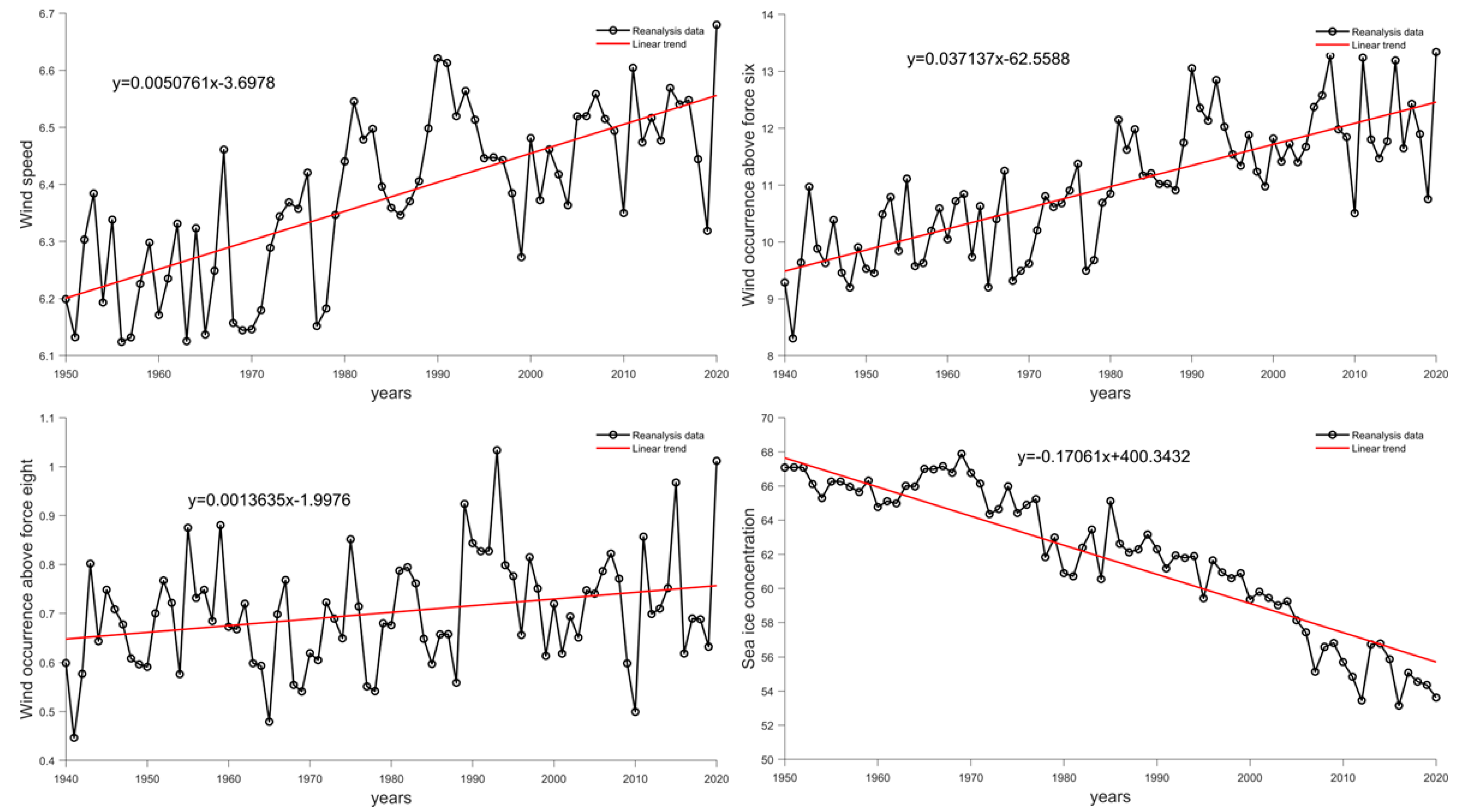
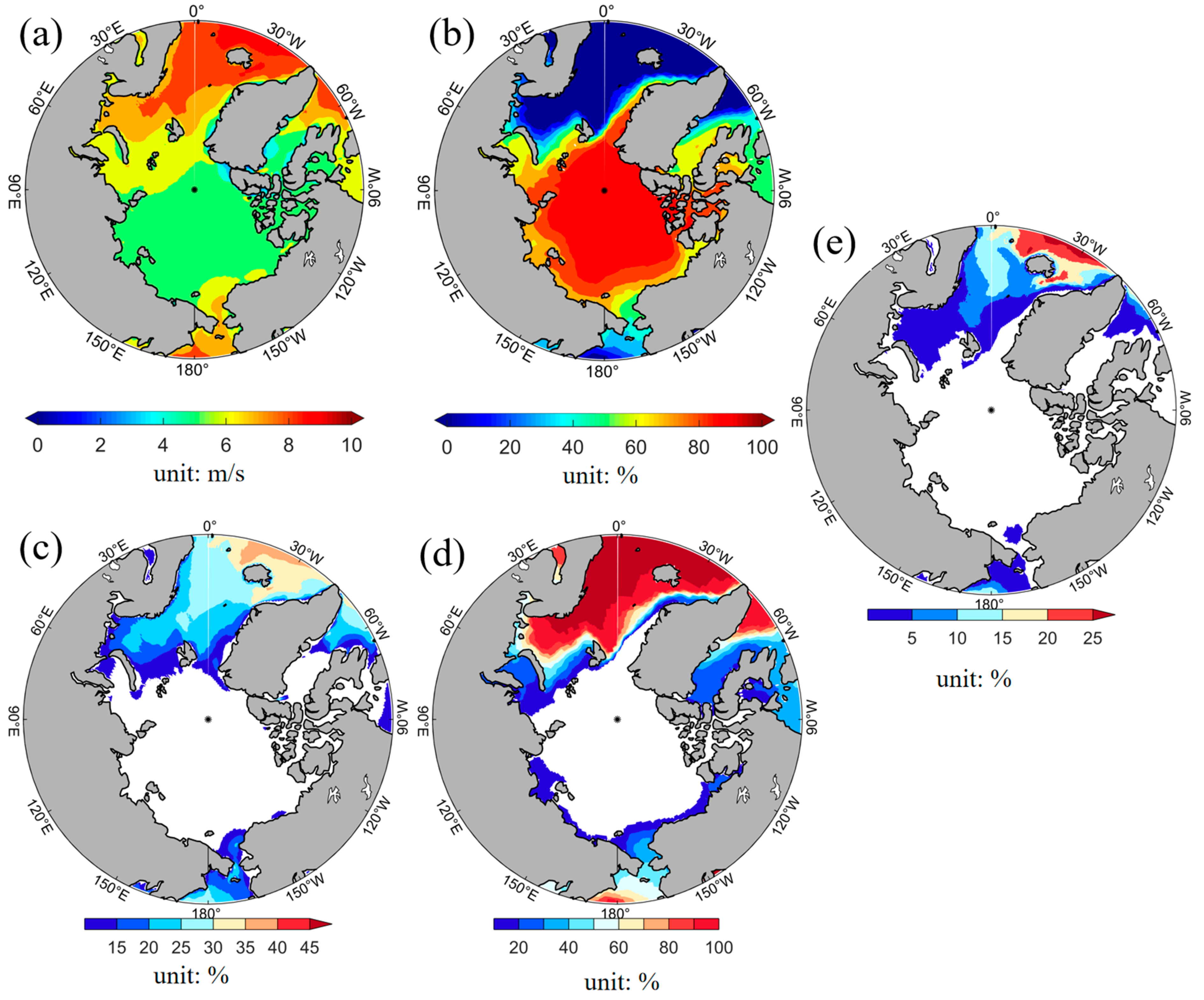

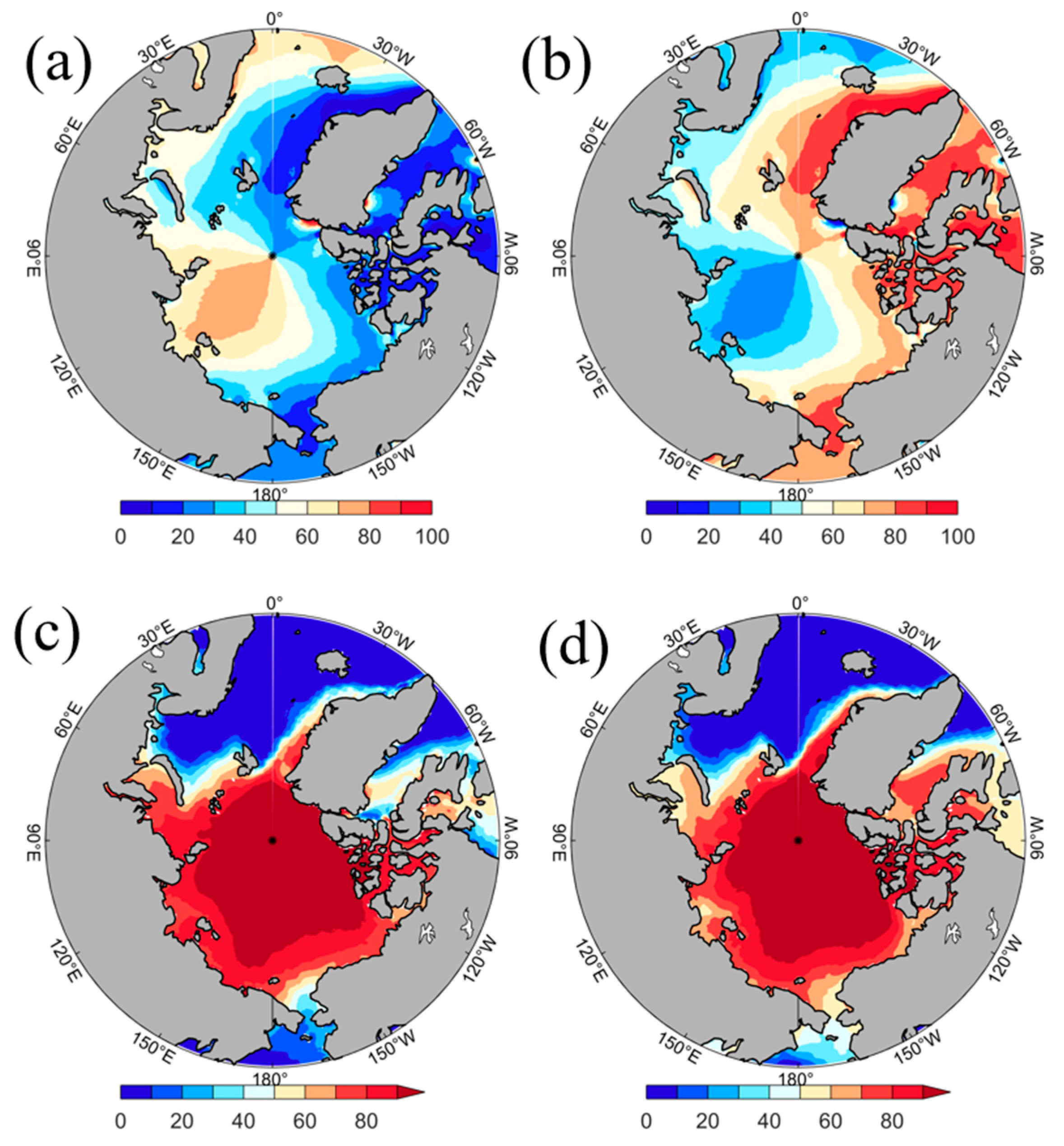
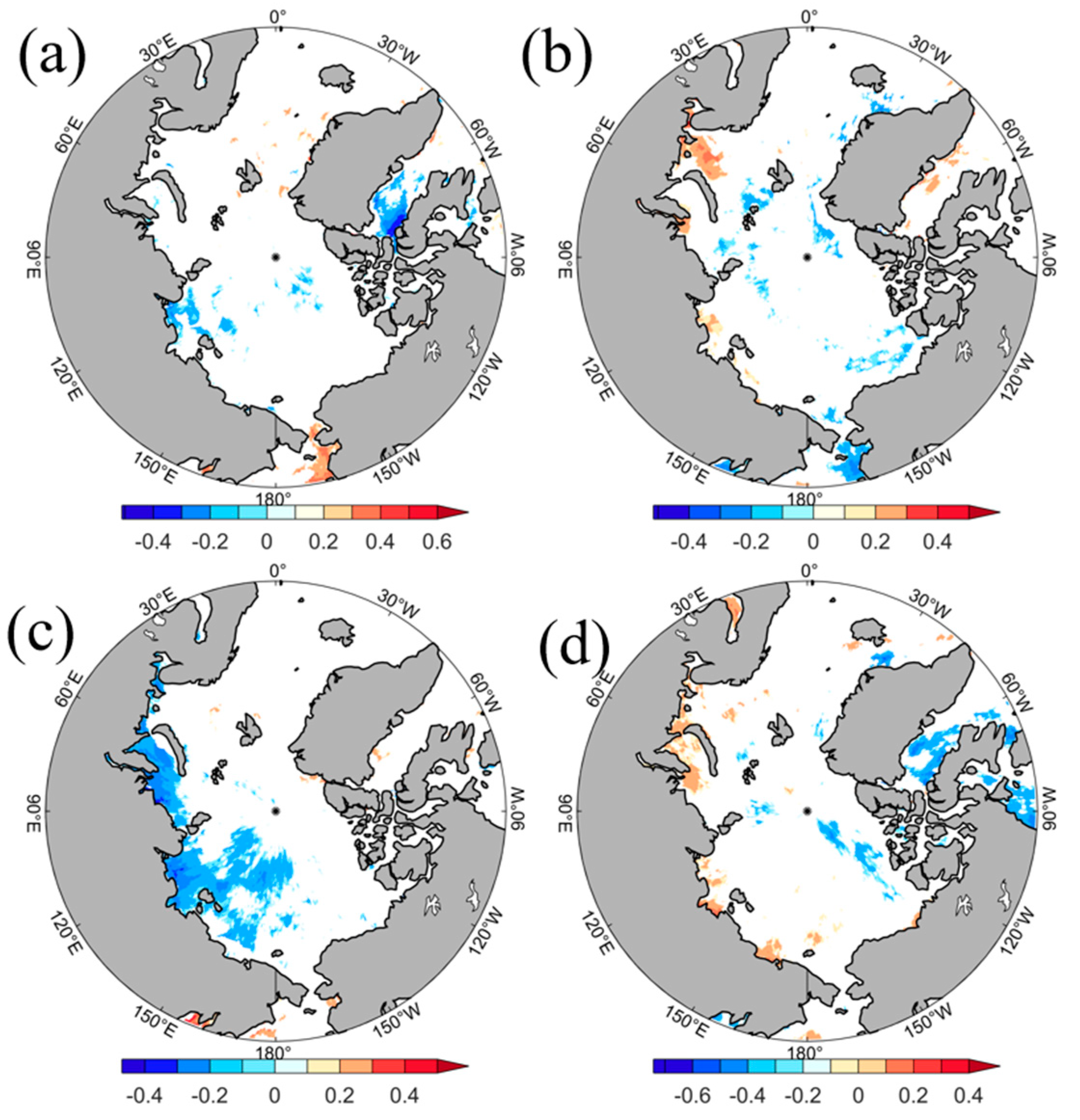
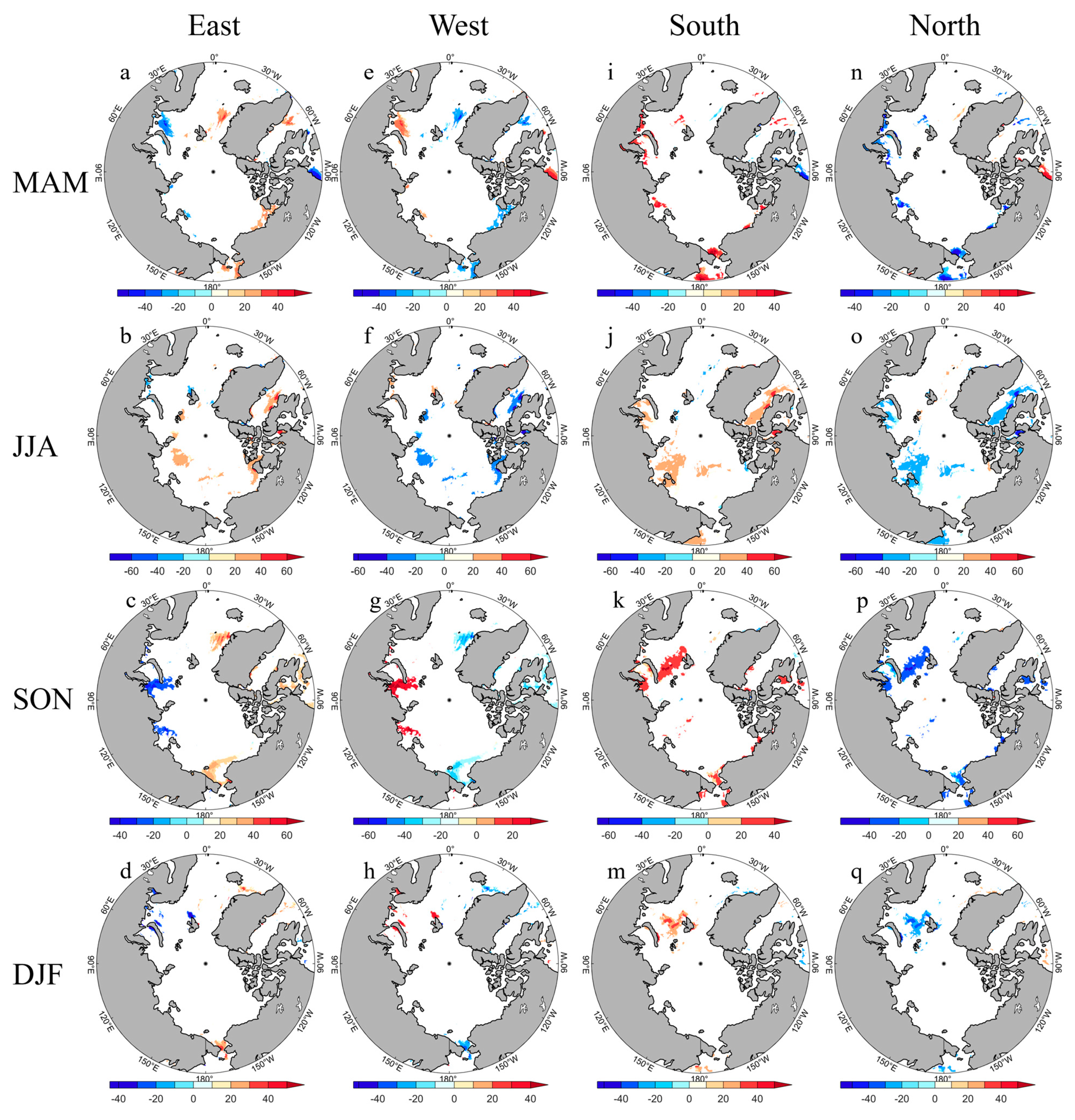

Disclaimer/Publisher’s Note: The statements, opinions and data contained in all publications are solely those of the individual author(s) and contributor(s) and not of MDPI and/or the editor(s). MDPI and/or the editor(s) disclaim responsibility for any injury to people or property resulting from any ideas, methods, instructions or products referred to in the content. |
© 2024 by the authors. Licensee MDPI, Basel, Switzerland. This article is an open access article distributed under the terms and conditions of the Creative Commons Attribution (CC BY) license (https://creativecommons.org/licenses/by/4.0/).
Share and Cite
Wang, K.; Guo, Y.; Wu, D.; Zheng, C.; Wu, K. Arctic Wind, Sea Ice, and the Corresponding Characteristic Relationship. J. Mar. Sci. Eng. 2024, 12, 1511. https://doi.org/10.3390/jmse12091511
Wang K, Guo Y, Wu D, Zheng C, Wu K. Arctic Wind, Sea Ice, and the Corresponding Characteristic Relationship. Journal of Marine Science and Engineering. 2024; 12(9):1511. https://doi.org/10.3390/jmse12091511
Chicago/Turabian StyleWang, Kaishan, Yuchen Guo, Di Wu, Chongwei Zheng, and Kai Wu. 2024. "Arctic Wind, Sea Ice, and the Corresponding Characteristic Relationship" Journal of Marine Science and Engineering 12, no. 9: 1511. https://doi.org/10.3390/jmse12091511





